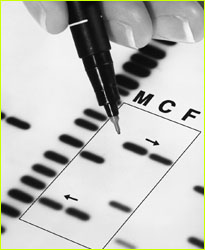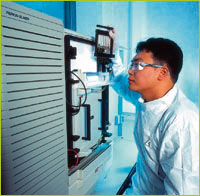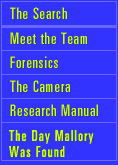 |
 |
 |
Forensics DNA profiling has become an extremely powerful tool in forensics and is increasingly used in criminal trials. If the bodies of Mallory and Irvine are found, scientists hope to use these new, cutting-edge techniques to convincingly identify the climbers using just a shred of evidence. Gill Rysiecki works for Cellmark Diagnostics near Oxford in the U.K., a lab that specializes in just such testing. NOVA: What sort of cases do you work on at Cellmark?
NOVA: If the team on Everest were to find the remains of what they thought to be Mallory or Irvine, how would you test for their identity? RYSIECKI: In this case, it's more like a paternity test that we would be doing, because we'd be comparing samples with living relatives to see whether we could establish a link. The key principles about DNA that we use in this analysis are the following. Each person has his or her own unique DNA. If I looked at your DNA it would be unique and different than mine. The only people that have the same DNA are identical twins. So, within an individual's body, all of the cells contain exactly the same DNA. When it comes to inheritance, we each inherit half our DNA from each parent. So, in the Mallory case, what we're looking for is some sample from the body that contains DNA. The difficulty in this case is that the death occurred such a long time ago, and DNA does get broken up and degraded quickly by bacteria. NOVA: What makes you think you'll still be able to do a good analysis, given how old the samples will be?
NOVA: How has DNA testing improved in recent years? RYSIECKI: There are now three generations of DNA testing. The main aim has been to make them more sensitive in terms of being able to detect smaller and smaller amounts of DNA. The push for that has been from the forensic applications. We have all three types of testing going on here. The very first type of testing is the most powerful, but it needs a lot of DNA. The latest type of testing requires very little DNA, it's very sensitive, and it's very quick. But it's not nearly as powerful as the first one. NOVA: What is the process of DNA profiling? RYSIECKI: In all three generations of DNA testing, what you have to do is extract the DNA from the sample, and that involves breaking open the cell. We usually do that with a detergent, which releases all the contents of the cell. There are proteins in there, there are lipids, and there is DNA. We purify the DNA away from the other components. The system we're most likely to use then is called the Polymerase Chain Reaction (PCR). That takes the DNA that you have and makes copies of it. So if you only have a small amount of DNA, by going through this PCR 20 or 30 times, you can amplify the amount of DNA you have until there is enough there to really analyze. NOVA: Is there a specific area of the DNA that you focus on?
So we would focus in on eight or nine of such areas of variability. And in each of these areas, the person we're looking at has two copies, one that they inherited from their mother and one from their father. So if we look at eight or nine of these areas, and we look at a man and his son, we'd find that half of the pieces in the man had been passed on to his son, so we should see 50 percent or more concurrence between the two. Of course, the other half would come from his mother. NOVA: How long would it take to get a definite result?
Back to The Search Photos courtesy of Cellmark Diagnostics. Lost on Everest | High Exposure | Climb | History & Culture | Earth, Wind, & Ice E-mail | Previous Expeditions | Resources | Site Map | Everest Home Editor's Picks | Previous Sites | Join Us/E-mail | TV/Web Schedule About NOVA | Teachers | Site Map | Shop | Jobs | Search | To print PBS Online | NOVA Online | WGBH © | Updated November 2000 |
 A lab technician analyzes samples of DNA.
A lab technician analyzes samples of DNA.
 A child inherits half of its DNA from each parent. In this result the
child has two bands, one inherited from its mother, the other from the father.
A child inherits half of its DNA from each parent. In this result the
child has two bands, one inherited from its mother, the other from the father.
 Could cutting-edge DNA profiling, only several years old, answer the 75-year mystery of Mount Everest?
Could cutting-edge DNA profiling, only several years old, answer the 75-year mystery of Mount Everest?
